Ecosystems and habitats
Kejimkujik National Park and National Historic Site
On this page
Freshwater habitats
Lakes and rivers
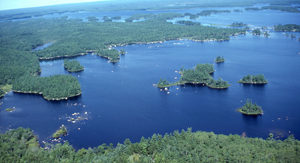
Photo: P. Hope
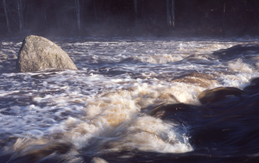
Photo: P. Hope
Kejimkujik inland contains 46 lakes and ponds and more than 30 streams and rivers, most of which are part of the Mersey River watershed. Originating north of the park, this watershed is the largest in Nova Scotia. Kejimkujik’s lakes and smooth-flowing rivers are largely a result of the last glaciation and make up approximately 15 percent of the park’s area. Park lakes have a natural, low-mineral content and therefore exhibit a high sensitivity to acidity. Most lakes have shallow, dark brown, acidic, seasonally warm water, with intervening rivers, still waters, and streams.
Atlantic Coastal Plain flora (which includes the threatened Water-pennywort), the threatened Northern ribbonsnake, and the endangered Blanding’s turtle are found along the shorelines of Kejimkujik inland’s freshwater ecosystems. Warm-water fish species such as Yellow perch, White perch, and Brown bullhead are distributed throughout, while Brook trout, which prefer colder water, seek spring up-wellings and deeper lakes to escape high summer water temperatures. Common loons nest on the shorelines of many of the larger lakes.
Dark Waters
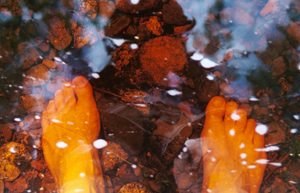
Photo: P. Jefferson Hopper
Approximately 12 percent of Kejimkujik consists of fresh water. The dark waters of these lakes and rivers have an intriguing story to tell. Most of the water comes from run-off. Kejimkujik’s slate, quartzite and granite rocks are hard and unyielding. This means that the waterways have few natural minerals. With so few nutrients, the productivity, or ability of the waters to support life, is very poor.
Forest habitats

The Acadian forest mix
Kejimkujik lies within the Acadian Forest zone, a transition between typically southern deciduous, or hardwood, trees and typically northern evergreen, or softwood, trees. Cutting has changed these forests dramatically over the last 200 years. Farmers cleared hardwoods from hills and loggers cut giant Red spruce, White pine, and harvested wood for pulp.
In 1974, the establishment of Kejimkujik National Park protected the forests from commercial cutting. Today, three-quarters of the Park’s woodlands are young, mixed stands of softwoods and hardwoods. Older White pines, which escaped fire and the axe, tower over the younger growth. Red maple, Large-toothed aspen, White birch, and Red oak stand out against a background evergreens.
Pockets of old-growth forest still stand tall in Kejimkujik. These stands are special because of their majesty and their rarity. Today, less than one percent of all the woodlands in Nova Scotia are over 100 years old. Since much of the region’s older forests are being lost to intensive harvesting, Kejimkujik is one of very few places where people can experience such woodlands. Old-growth forests are an important habitat that Kejimkujik protects.

Photo: P. LaLonde
Old-Growth Hemlocks
About one-fifth of Kejimkujik’s forests are softwoods. A fraction of these are towering groves of old-growth Eastern hemlocks. Pure hemlock stands create an open and quiet forest atmosphere. They began to establish themselves hundreds of years before today’s 350-year old trees even took root. Although some foresters consider old trees “overmature,” these old-growth woodlands have important value.
Hemlocks have fine feathery needles that create a layered canopy, which allows little sunlight to hit the forest floor. Under this shade, few plants can grow except for thick mosses and liverworts. These cool and shaded forests also favour delicate and uncommon orchids, such as Spotted coral-root and Checkered rattlesnake plantain.
The shallow roots of tiny hemlock seedlings are supported by the moist soils. Hemlock seedlings can survive in the shade, and since they are long-lived, they eventually dominate the forest.
On the forest floor, mushrooms recycle nutrients from fallen needles, twigs, and branches while bracket fungi grow like shelves on tree trunks. Where huge old trees have blown down, the extra nutrients provide for the new growth of dense patches of hemlock seedlings and ferns. This creates a variety of habitats for wildlife, lichens, and fungi.
Even the treetops provide homes for wildlife. The Northern goshawk, a powerful and swift woodland hunting hawk, prefers to nest in these hemlock stands. The thick upper canopy hosts many insects, which provide important feeding and nesting habitat for the Blackbunian warbler, a bird easily identified by its orange throat.
A walk among the awe-inspiring giants on the Hemlock and Hardwoods trail allows you to experience the beauty and wonder of these special forests.
Old-Growth Hardwoods
Old-growth hardwood forests in Kejimkujik are found on top of glacially-formed hills where the soil is deep and well drained. These forests are hundreds of years old. Although they make up less than one percent of Kejimkujik, you can see excellent stands along the Peter Point Trail and the Big Hardwood Carry (Portage E).
Impressive Yellow birches, Sugar maples, and Beech trees comprise the upper canopy. The smaller Striped maples, often heavily browsed by deer, survives in the shade below. More light comes through the canopy of a hardwood stand than in a hemlock stand, allowing ground cover such as ferns to grow there.
Beech trees, once a healthy part of these forests, have been hard hit by a fungal disease and an insect introduced from Europe over a century ago. Cankered and stunted beeches are widespread in Nova Scotia although occasional smooth-barked giants can be spotted.
Old-growth hardwood forests, with their lush growths of lichens, abundant seeds and nuts and many tree cavities, provide good habitat for birds and small mammals such as the Southern flying squirrel.
Wetland habitats
Wetlands have a major influence on the water chemistry, level and colour of freshwater ecosystems, and provide habitat for many of the species at risk in the park, including the Blanding’s turtle, the Northern ribbonsnake, and Atlantic Coastal Plain flora.
Bogs
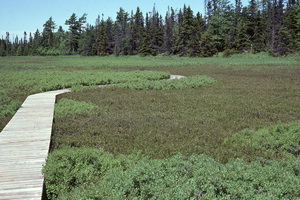
Bogs are the most common type of wetland in Nova Scotia, and a significant habitat in the park. They grow in areas of poor drainage and fill up old lakes. To discover Kejimujik’s bogs, hike the Snake Lake Trail, paddle Jeremys Bay, Still Brook, or one of the other slow-moving waterways. Bogs take centuries to develop. They are saturated with water and are dominated by mats of spongy sphagnum moss. As the moss grows and dies, the plant material rots very slowly forming layers of dead moss called peat that can become several metres deep. The dark brown waters, so characteristic of Kejimkujik, are stained with tannic acids from this peat.
On the drier parts of bogs, waist-high shrubs grow including Leather-leaf, Sheep laurel, and Rhodora. These species can tolerate the acidic conditions. Even the most moisture-tolerant tree species, including Larch, Red maple, and Black spruce, survive mostly on raised hummocks and around the bog’s edge.
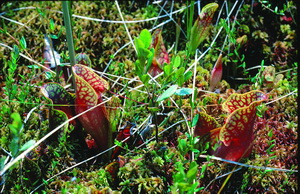
Photo: R. Swain
Some plants have special adaptations to the nutrient-poor growing conditions. Pitcher-plants and Sundews trap and digest insects to supplement their diet. Orchids use specific soil fungi to get enough nutrients to produce their delicate flowers. The bogs that we often regard as soggy, prickly, and tangled obstacles are the preferred nesting areas for some birds, especially the Palm warbler, Swamp sparrow, and Common yellowthroat. From the purple blanket of Rhodora blossoms in the spring to the cranberries of fall, bogs are beautiful.
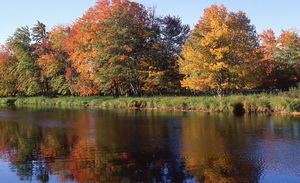
Floodplains
Flat wetland areas bordering rivers and other waterways are known as floodplains. In Nova Scotia, floodplains often appear as lush, grassy meadows in summer. In Kejimkujik, the trail crossing Rogers Brook offers one of the best views of a floodplain.
Floodplain lands and adjacent waters form a complex and dynamic ecosystem. When river waters overflow due to seasonally heavy rains or spring runoff, these important riparian areas collect and retain the floodwaters. Not only do floodwaters carry plant material and silt laden with nutrients, wetting of the floodplain surface releases its own nutrients: those left over from the last flood, and those resulting from the rapid breakdown of organic matter that has accumulated since then. The combination of high nutrient-levels, high moisture and periodic physical disturbance creates unique, productive habitat for plants and wildlife, including rare species.
As the levels of a floodplain increase, moisture-tolerant trees and other forest vegetation such as maples and alders eventually gain a foothold. Plants found in Kejimkujiks’s floodplains include Blue flag iris, Poison ivy and Meadowsweet. Dragonflies, salamanders, turtles, owls, birds, bats, beavers and White-tailed deer are among the species that depend on the floodplains. The crowns of the trees also support rich insect and bird life. Warblers, vireos and flycatchers are some of the birds sighted in the forest floodplain.
The Seaside protects a small and representative part of the Nova Scotia coastline. The province’s coastal regions are more densely populated than the interior. Such wildernesses are extremely valuable. Canada’s national parks are part of a network that seeks to represent all of the natural regions of the country. Kejimkujik is an inland park representing the Atlantic Coast Uplands Natural Region. The Seaside was added to the park in 1988 to represent the coastal features of this natural region.
Kejimkujik Seaside

Barrens
As you approach the ocean, leaving the shelter of the forest behind, the coastal barrens stretch out before you. This is a zone of vegetation generally about the height of an adult human. Cold and salty winds from the ocean clip the growth of plants, causing them to be stunted and twisted.
Barrens form along Nova Scotia’s coast where the rigours of the climate combine with soil conditions. The thin, poor soil left after glaciation also forms an impervious iron-rich hardpan that plant roots find difficult to penetrate. The effects of fire may have removed much of the soil humus. Attempts to farm and graze sheep on this land have also had a major influence.
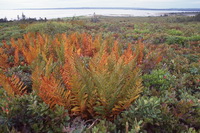
Despite the name, the barrens are a diverse and fascinating habitat. This landscape is actually a miniature Acadian forest. Stunted White pine and Red maple are present. Black spruce, Balsam fir, and Wire birch grow not much taller than the multitude of shrubs such as blueberry, Sheep laurel, Bearberry, Canada holly, and huckleberry. Many of these shrubs are prolific berry producers later in the summer. Birds and sometimes Black bears can be seen feasting on the rich bounty. Beneath the twisted, impenetrable, and dwarfed trunks of tree and shrub, there is a forest floor. A lush growth of Cinnamon ferns, Wintergreen, Bunchberry, and mosses are found here. This is also a haven for many small animals like Snowshoe hare, Red squirrel, and other small rodents who seek the shelter offered by the thick vegetation. Birds like the Common yellow-throat warbler, the Savannah sparrow, and the Palm warbler flit in and out of the branches. These small creatures move easily in the tangle of shrubs and dwarfed trees typical of the barrens.
Nearer the ocean, the barrens become more stunted. The shrubs give way to Crowberry, Reindeer moss, and Ground juniper that grow right up to the beach’s edge.
The very low barren can harbour toads, snakes, voles, and shrews. The moist conditions also favour the Eastern red-backed salamander. In the past, moose and caribou found ideal living conditions in these low barrens. Mainland moose are now considered an endangered species and the last Woodland caribou disappeared from Nova Scotia around 1905.

Bogs
In some bogs the woody shrubs all but disappear and the vegetation does not pass knee height. Typically damp and mossy places, bogs look quite uniform from a distance. But up close, there is a diverse mixture of plants, colours, and textures. Sphagnum moss dominates the bog and gives it its peaty character, including water saturation and high acidity. Plants that also grow here include Bog laurel, Bog huckleberry, Three-leaved false Solomon’s seal, White-fringed orchids, Rhodora, and Sweet gale. All of these plants thrive in the bog conditions which prevent many other plants from growing.
At the Seaside, the bogs are pierced with large boulders. These boulders are called glacial erratics and remind us of the relatively short span of time that has passed since the last Ice Age swept over Nova Scotia. Many of the seaside bogs began as small ponds that formed when the last of the glaciers melted along the coast about 13 000 years ago. Cool and damp, this landscape encouraged the growth of sphagnum. The moss gradually filled in all of the ponds to form bogs.
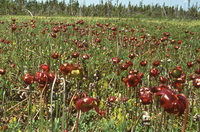
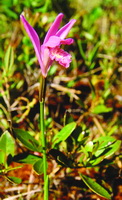
Unusual plants populate the bog. Pitcher plants, Horned bladderwort, and Sundew augment their meagre rations taken from the sterile peaty soil with insects. During June and July, orchids like Rose pogonia, Calopogon, and Arethusa display splendid flowers. Tufted seed heads of Bog cotton float like clouds above the surface of Sphagnum moss. Certain trees do seem to be able to endure: Wire birch, Black spruce, Balsam fir, and sometimes even White pine adapt to the conditions. Bare, branchless trunks face into the predominant winds, while most of the growth is directed downwind on low, lateral branches. Due to the extremely slow rate of growth, trunks of a few centimetres in diameter may contain up to one hundred very fine growth rings.
Few animals live in the bog but many inhabit the perimeter and make use of it. Song sparrows and Swamp sparrows are common. White-tailed deer criss-cross the bog with trails, seeking food during calm days, but when North Atlantic storms hit land, they will leave for more dependable shelter in the surrounding forest or in islands of spruce trees.
Forest islands
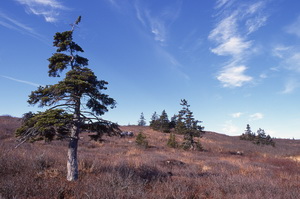
As you look over flat bogs and barrens, islands of trees poke up in the distance. Stunted and twisted, these Balsam fir and White spruce grow close to the ocean’s edge, withstanding even the salt spray. Zones of deeper, more well-drained soil are found here, which is more conducive to tree growth than the sterile, water-logged peat of bogs. Also, where the land slopes down steeply towards sheltered bays, in the lee of the predominant winds, trees grow higher.
Ponds
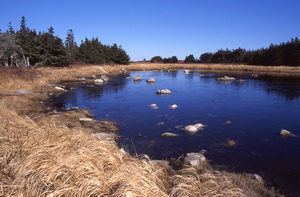
The Seaside has several small ponds. Many of them are found along the shore or at the ends of headlands. Little more than a pile of gravel and cobbles separates them from the Atlantic Ocean. Fresh water comes only from rain seepage from the boggy basins surrounding each pond. The salinity of the pond water can vary quite a bit from pond to pond and from season to season. Some even dry up during the summer. The water in these shallow ponds is very dark and contains high amounts of dissolved organic compounds such as tannic acids. While no real brooks flow in or out of them, you can often see their dark-stained water seeping through the beach gravel on the seaward side of the cobble berms. The water is very acidic, ranging from 3.9 to 4.9 on the pH scale. These can be difficult places for aquatic life to live.
Green maidenhair algae and Burweed may cover the bottoms of the brackish ponds. Fish like Sticklebacks and Mummichogs are well adapted to living in water where the salinity fluctuates. The mud around the edges may show traces of great blue herons who have come fishing. Black ducks use these ponds for raising their broods. Gulls also flock here to rest and look for food or shelter from ocean storms.
There are a few inaccessible freshwater ponds inland. Far from the direct influence of the sea, common Nova Scotia amphibians can be found. Green frogs, Northern leopard frogs, and Spring peepers migrate from inland and sometimes live in these dark and acidic waters. Generally, because of these conditions, and the cool nature of the climate, frogs and other amphibians are not abundant in Kejimkujik Seaside.

Capes
The capes of the Seaside project directly into the raw energy of the Atlantic Ocean. Smooth rocky ridges jut out into the turmoil of waves. Spray jumps up into the air sometimes giving your lips a salty tingle. If it is low tide, bands of Rockweed are like skirts on the rocks and declare clearly that the ocean claims this territory. If you explore these outcrops, be careful; rogue waves can reach up and carry away anything they find. They have already carried away the soil and forest that once covered these rocks, exposing an ancient geological story below.
Cobbles
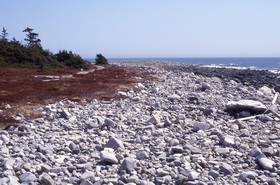
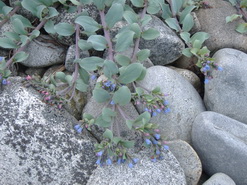
Most of the coastline is composed of granite cobbles. Ranging in size from 10 to 30 cm, these rocks are round and smooth. The ocean has rolled and worn the granite down into the almost perfectly round and smooth cobbles and then, with brute force, flung them upon the land. Many of the cobble beaches are raised into impressive, steep banks called berms. Rising many metres above the average high tide, only the biggest storms succeed in crashing over the top. Each storm surge will dump tonnes of rock at the crest of the cobble berm, spilling landward, covering barrens and stunted spruce trees, even filling up ponds.
Many people admire the symmetrical granite cobbles but should never-the-less refrain from bringing home souvenirs. Leave the beach as you found it for the next visitor!
The rising tides leave many things stranded on the cobble beach. A rich and varied strand line seems to contain a complete history of the evolution of the lobster trap – beginning with the older wooden hoop and slat, through the square slat and finally the metal cage. Abundant driftwood contains other relics of the human fishing industry, stumps, and logs. Beyond the reach of wave action, cobbles are more stable and become colonized by encrusting lichens and plants, such as Sea-lungwort, Beach pea, and Common juniper. Sweet gale and cranberries establish themselves eventually and merge with the barrens inland.
Many small coastal ponds are separated from the salty ocean by the cobble berm. As these natural dykes are very dynamic and porous barriers, the conditions in these ponds are very challenging.
Islands
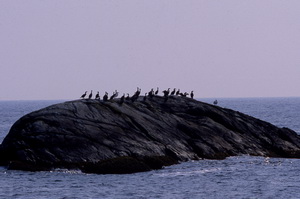 Cormorants perched on boulders
Cormorants perched on boulders Large boulders can be seen farther out in the water forming handy and secure nesting and roosting sites for birds like gulls, Black guillemots, Petrels, Terns, and Gannets. Look for Cormorants drying out their outstretched wings between dives. Eiders also roost on these islets throughout the year. Bird rocks are typically painted white with excrement, marking that spot as a favourite place.
Harbour seals, and the larger Grey seals, tend to prefer those rocks that have easily accessible shelves where they can pull themselves out of the water. The seals spend the entire year in and around these rocks. Even in winter, they will sun themselves but tend to prefer the warmer water. During the spring, females will give birth to their pups in the relative safety of these small islands. During the summer, they divide their time between resting and playing on the rocks and fishing. Whales are seldom seen at Kejimkujik’s Seaside.
Coves
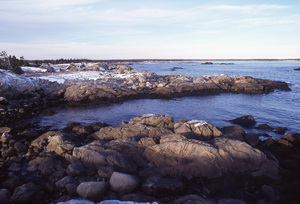 Calm seaside cove
Calm seaside cove The open North Atlantic Ocean is sometimes too exposed for many species of wildlife. Boyds Cove, Port Joli, MacLeods Cove, Harbour Rocks, and Port Mouton offer an easier option. Warmer, calmer waters of coves attract fish and shelter more marine plants. Hundreds of seabirds can often be found in large rafts, bobbing up and down in the waves, including Common eiders, Surf scoters, Cormorants, Black ducks, wintering Canada geese, and Green-winged teal. The more protected waters favour the growth of marine plants, particularly kelp. Kelp shelters schools of young fish, provides food for grazers like periwinkles, and make a more hospitable environment for many creatures.
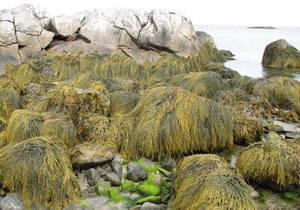

Beaches
One of the most spectacular views in Nova Scotia awaits the visitor at Kejimkujik’s Seaside. From the Harbour Rocks trail, the sweeping curve of St. Catherine’s River beach is unveiled. The white sand is blinding on a sunny day. When dry, because of the uniform shape of the quartz sand grains, it “talks” as a person walks over it. This is one of the largest protected beaches in Nova Scotia.
The beaches are created by the action of current and waves that deposit fine sand in the sheltered coves of the Seaside. The sand is a product of the granite that lines the shoreline. Granite contains large amounts of quartz, a very hard and light coloured mineral. White sand, reflecting sunlight off the ocean floor is responsible for the unbelievable turquoise colour of the water. Darker patches are also present which represent those parts of the ocean floor that are covered in rock. Rocky areas are covered with seaweeds.
In some areas, the white sand contains unusual purple bands. This purple sand is actually very fine particles of garnet. This magnesium-rich mineral has been eroded from the surrounding rocks. It is very fine and less dense than the sand particles that make up the rest of the beach. Wave action is therefore able to move it to the highest part of the beach. Wind then collects and deposits it at the base of the dune grass or in other wind-traps.
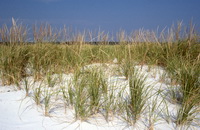
Just inland from the high tide zone on sandy beaches are wind-created dunes. Beaches are constantly being altered by the forces of the wind and the sea and can change dramatically over the course of a season. Winter storms can wash out, breach, or even move dunes around. Marram grass is the dominant plant on the dunes, holding the sand in place with its dense network of roots. The base of the dunes is critical nesting habitat for the endangered Piping plover.
Heading inland, older dunes are more stable with their carpet of Marram grass, rose, Bayberry, Poison ivy, and even the occasional white spruce. Beach pea, Starry false-Solomon’s seal, and Seaside goldenrod also grow here. Few animals live permanently on the dunes but deer and raccoons do leave traces of their passage.

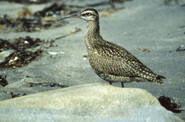
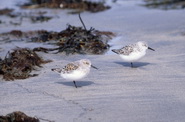
The most common birds seen on sandy beaches include Spotted sandpipers in the early summer and flocks of Semi-palmated sandpipers, Least sandpipers, Sanderlings, Willets, and Semi-palmated plovers later on. These shorebirds run back and forth between the breaking waves on the beach picking up morsels of food like sandhoppers or sideswimmers. Common terns nest on the tip of St. Catherine’s River Beach. Many of these birds are migratory and make use of the Seaside’s beaches on their way to somewhere else. These beaches are therefore directly connected to coastal areas in the southern United States, the Carribean, and as far away as Antarctica.
Shells and scattered pebbles help make this beach ideal for Piping plover nests because they use these bits of flotsam to help camouflage their shallow nest depressions in the sand. The presence of the plovers and the importance of the Marram grass, which is sensitive to foot traffic, in holding down the sand, makes these dunes very special places. Avoid walking on dunes and respect beach closures where indicated.
Lagoons
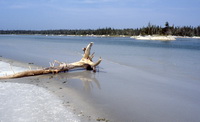
Beaches like St. Catherine’s River Beach and Little Port Joli beach create a sheltered body called a lagoon in behind their sandy barrier where fresh and salt water intermingle. Tides rush in through the narrow opening created by the barrier beach, flooding tidal flats and surrounding small islands with an influx of fresh, cold salt water. The lagoons experience high and low tides about every 6 hours. The fine mud which collects here is rich in nutrients and absorbs lots of heat during low tide. Fine algae grows on the mud and it can be baked into a bleached cardboard-like substance by the sun. Many types of insects and crustaceans seeks shelter from the drying sun under these mats. Eel grass provides a rich grazing ground for many shorebirds, ducks, and geese. Eagles, osprey, and herons regularly fish in the lagoon shallows. Lagoons are important nurseries for many types of fish, including the Mummichog and the Stickleback. Large numbers of marine creatures such as Soft shell clams, periwinkles, and Macoma clams are common. Raccoons come down to the lagoon’s edge to feed on these shellfish. Salt marshes, with their cordgrass and rushes fringe the lagoon.
Related links
- Date modified :